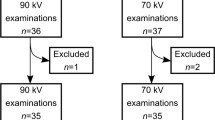Abstract
Background
Radiographer reporting has been studied for plain films and for ultrasonography, but not in paediatric brain CT in the emergency setting.
Objective
To study the accuracy of radiographer reporting in paediatric brain CT.
Materials and methods
We prospectively collected 100 paediatric brain CT examinations. Films were read from hard copies using a prescribed tick sheet. Radiographers with 12 years’ and 3 years’ experience, respectively, were blinded to the history and were not trained in diagnostic film interpretation. The radiographers’ results were compared with those of a consultant radiologist. Three categories were defined: abnormal scans, significant abnormalities and insignificant abnormalities.
Results
Both radiographers had an accuracy of 89.5% in reading a scan correctly as abnormal, and radiographer 1 had a sensitivity of 87.8% and radiographer 2 a sensitivity of 96%. Radiographer 1 had an accuracy in detecting a significant abnormality of 75% and radiographer 2 an accuracy of 48.6%, and the sensitivities for this category were 61.6% and 52.9%, respectively. Results for detecting the insignificant abnormalities were poorer.
Conclusions
Selected radiographers could play an effective screening role, but lacking the sensitivity required for detecting significant abnormality, they could not be the final diagnostician. We recommend that the study be repeated after both radiographers have received formal training in interpretation of paediatric brain CT.

Similar content being viewed by others
References
Erly WK, Ashdown BC, Lucio RW II et al (2003) Evaluation of emergency CT scans of the head: is there a community standard? AJR 180:1727–1730
Lo RH, Chan PP, Chan LP et al (2003) Routine abdominal and pelvic ultrasound examinations: an audit comparing radiographers and radiologists. Ann Acad Med Singapore 32:126–128
Leslie A, Lockyer H, Virjee JP (2001) Who should be performing routine abdominal ultrasound? A prospective double-blind study comparing the accuracy of radiologist and radiographer. Clin Radiol 56:166–167
Brealey S, Scally A, Hahn S et al (2005) Accuracy of radiographer plain film reporting in clinical practice: a meta-analysis. Clin Radiol 60:232–241
Berman L, de Lacey G, Twomey E et al (1985) Reducing errors in the accident department: a simple method using radiographers. Br Med J 290:421–422
Renwick IG, Butt WP, Steele B (1991) How well can radiographers triage X-ray films in the accident and emergency department? Br Med J 302:568–569
Brealey S, Scally A, Hahn S et al (2006) Accuracy of radiographers red dot or triage of accident and emergency radiographs in clinical practice: a systematic review. Clin Radiol 61:604–615
Loughran CF (1994) Reporting of fracture radiographs by radiographers: the impact of a training programme. Br J Radiol 67:945–950
Erly WK, Berger WG, Krupinski E et al (2002) Radiology resident evaluation in the emergency department. AJNR 23:103–107
Wyosoki MG, Nassar CJ, Koenigsberg RA et al (1998) Head trauma: CT interpretation by radiology residents versus staff radiologists. Radiology 208:125–128
Lal NR, Murray UM, Eldevick OP et al (2000) Clinical consequences of misinterpretations of neuroradiologic CT scans by on-call radiology residents. AJNR 21:124–129
Hillier JC, Tattersall DJ, Gleeson FV (2004) Trainee reporting of computed tomography examinations: do they make mistakes and does it matter? Clin Radiol 59:159–162
Donovan T, Manning DJ (2006) Successful reporting by non-medical practitioners such as radiographers will always be task specific and limited in scope. Radiography 12:7–12
Author information
Authors and Affiliations
Corresponding author
Rights and permissions
About this article
Cite this article
Brandt, A., Andronikou, S., Wieselthaler, N. et al. Accuracy of radiographer reporting of paediatric brain CT. Pediatr Radiol 37, 291–296 (2007). https://doi.org/10.1007/s00247-006-0401-1
Received:
Revised:
Accepted:
Published:
Issue Date:
DOI: https://doi.org/10.1007/s00247-006-0401-1




